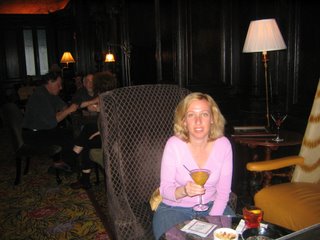 Now the history seeking tourist can drink with pleasure. A sense of the hotel's past is everywhere, from the tiny couch across from the front desk for the Algonquin house cat Matilda to Natalie Ascencios's painting "A Vicious Circle" hanging behind the round table. We arrived on a wet afternoon and were immediately charmed by the dark wood lobby and the cocktail lounge filled with comfortable chairs, framed photos of famed guests, and, perhaps, guests about to be famous working at their laptops. The courteous staff were amused as we took photos of the round table, painting, lobby, piano and each other. We then settled at a tiny table and sank into a larger version of Matilda's couch to drink in the Algonquin experience.
Now the history seeking tourist can drink with pleasure. A sense of the hotel's past is everywhere, from the tiny couch across from the front desk for the Algonquin house cat Matilda to Natalie Ascencios's painting "A Vicious Circle" hanging behind the round table. We arrived on a wet afternoon and were immediately charmed by the dark wood lobby and the cocktail lounge filled with comfortable chairs, framed photos of famed guests, and, perhaps, guests about to be famous working at their laptops. The courteous staff were amused as we took photos of the round table, painting, lobby, piano and each other. We then settled at a tiny table and sank into a larger version of Matilda's couch to drink in the Algonquin experience. Classic (and very expensive) cocktails are a must so we began with the Matilda, a lovely mix of Mandarin Absolut, cointreau, orange peel, and champagne. Then a New Yorker, a Negroponi, and of course a martini (or two). The cocktails are served on a napkin printed with Parker's martini poem, accompanied by a bowl of salted nuts. As we sank deeper into the couch, a pianist softly played Cole Porter and Gershwin and history became alive.
Classic (and very expensive) cocktails are a must so we began with the Matilda, a lovely mix of Mandarin Absolut, cointreau, orange peel, and champagne. Then a New Yorker, a Negroponi, and of course a martini (or two). The cocktails are served on a napkin printed with Parker's martini poem, accompanied by a bowl of salted nuts. As we sank deeper into the couch, a pianist softly played Cole Porter and Gershwin and history became alive.For readers of "The New Yorker" the Algonquin is a holy shrine. "The New Yorker" was founded in 1925 by Harold Ross, a regular at the round table. "New Yorker" writers and editors would gather regularly at the Algonquin for lunch. Faulkner wrote his Nobel Prize speech in his Algonquin room in 1950; Gertrude Stein often stayed at the Algonquin as well. Actors, writers, musicians, the rich and the famous have stayed at and written about the hotel. Aware of its unique history, the Algonquin provides a leaflet "Tribal Tales of the Algonquin" featuring "New Yorker" ads from 1931 and facts about the hotel's noted visitors.
In the warm glow of $13 cocktails, classic American music, soft chairs, dark wood, Japanese wallpaper, images of "the vicious circle", thoughtful and attentive service, literary history is as exciting now as it was being made in "that glorious decade".
The Algonquin Hotel
59 West 44th St.
New York, New York 10036
212-840-6800
www.AlgonquinHotel.com



